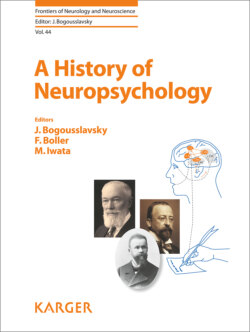Читать книгу A History of Neuropsychology - Группа авторов - Страница 34
На сайте Литреса книга снята с продажи.
War Times, Questionnaires, and Group Studies
ОглавлениеWorld War I sadly supplied much data for the understanding of personality changes due to brain trauma [16]. However, World War II triggered more systematic and larger-scale assessments: Interviews and questionnaires with features amenable to quantification and scoring thus resulted in first group studies.
Large cohort studies with patients based on war records were carried out retrospectively. For instance, Lishman examined psychiatric and behavioral disabilities after head injury from the Oxford collection of head injury records, compiled during World War II [17]. A detailed follow-up was available up to 5 years after the acute stage for most patients, much of this material consisting of questionnaires listing a wide range of symptoms. In Lishman’s study, altered behavior was part of the category “psychiatric disability” defined “as disturbance in any area of mental life, as reflected by impaired intellectual function, disorder of affect, disorder of behavior, somatic complaints without demonstrable physical basis, and/or formal psychiatric illness.” Affective disorders consisted of depression (episodic or continuous), emotional lability, morbid anxiety and phobias, irritability, overt aggression, apathy, loss of initiative and euphoria, whereas behavioral disorders involved crime or misdemeanours, sexual disturbance, lack of judgment, reliability, consideration for others, childish or facile behavior, restlessness, impulsiveness, and disinhibition. Likewise, Grafman et al. [18] retrospectively investigated the presence of aggressive and violent behavior in veterans who suffered a penetrating brain injury during their service in Vietnam. Besides an open question asked by the neurologist (“Have you ever had any violent behavior against persons or things? We all lose our temper now and then, but have you ever beaten someone up or torn up a room?”), the veteran and family members completed questionnaires. It included the Beck Depression Inventory [19], the Katz Adjustment Scale (relatives’ judgment of the subject’s competency across a variety of social and behavioral domains) [20], and the VHIS Family Questionnaire (addressing the relatives’ ability to cope with the subject’s behavior). Finally, the examiner filled in the Neurobehavioral Rating Scale, an inventory sensitive to aberrant behavior [21]. Overall, questionnaires were quantitative, interrogated patients and relatives, and therefore led to more systematic assessments. This set-up allowed the evaluation of behavioral deficits on large cohorts of individuals, as well as conducting follow-up investigations to shed light on the long-term outcome of patients.
